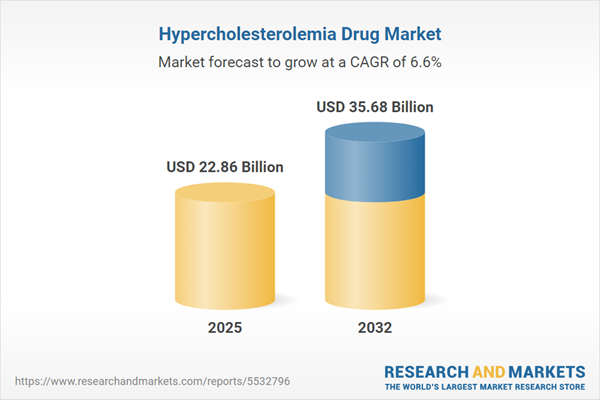Speak directly to the analyst to clarify any post sales queries you may have.
The hypercholesterolemia drug market is entering a period of sustained transformation, propelled by advances in therapeutics and increasing focus on individualized patient outcomes for cardiovascular health.
Market Snapshot: Hypercholesterolemia Drug Market Growth
The Hypercholesterolemia Drug Market grew from USD 21.43 billion in 2024 to USD 22.86 billion in 2025, with a projected CAGR of 6.58%, reaching USD 35.68 billion by 2032.
Growing healthcare demand, the emergence of innovative biologics, expanding access in emerging economies, and shifting regulatory priorities underpin this robust expansion. Investment in combination therapies, digital adherence technology, and regulatory alignment is contributing to broader adoption and more sophisticated commercialization strategies worldwide.Scope & Segmentation
This report delivers granular insights across every major segment of the hypercholesterolemia drug ecosystem:
- Drug Classes: ATP citrate lyase inhibitors, bile acid sequestrants, cholesterol absorption inhibitors, fibric acid derivatives, niacin derivatives, PCSK9 inhibitors (including monoclonal antibodies), branded and generic statins.
- Distribution Channels: Hospital pharmacy (inpatient and outpatient), online pharmacy, retail pharmacy (chain and independent).
- Route of Administration: Oral formulations (capsules, tablets), injectable options (intravenous, subcutaneous).
- Disease Types: Primary hypercholesterolemia (familial, nonfamilial), secondary hypercholesterolemia (diabetes-related, metabolic syndrome-related, obesity-related).
- Age Groups: Adult (18-64, 65 and above), pediatric patients.
- Treatment Lines: Adjunct therapy (niacin, omega-3 fatty acids), first line (monotherapy, combination therapy), second line (bempedoic acid, PCSK9 inhibitor).
- Regions: Americas (including North America and Latin America), Europe, Middle East & Africa, Asia-Pacific regions, with analysis of developed and developing submarkets.
- Key Companies: Amgen, Sanofi, Regeneron Pharmaceuticals, Novartis, Merck, AstraZeneca, Pfizer, Esperion Therapeutics, Kowa Company, and Daiichi Sankyo.
Key Takeaways: Strategic Insights for Decision-Makers
- Expanded drug portfolios and next-generation therapies are redefining the hypercholesterolemia landscape, supporting personalized regimens and improving clinical outcomes.
- Digital health platforms and real-world evidence analytics are enabling tailored patient management and strengthening value-based contracting across payer networks.
- Stakeholders are pursuing manufacturing agility and supply chain resilience to remain competitive amid evolving global trade and geopolitical dynamics.
- Segment growth is propelled by therapy innovation not only in LDL-C lowering but also in addressing residual cardiovascular risk through novel biomarkers and inflammation modulators.
- Competitive differentiation is emerging through strategic collaborations, integration of digital adherence tools, and expansion into high-growth regions where regulatory harmonization and local partnerships are accelerating access.
Tariff Impact: U.S. Measures Transforming Supply Chain and Pricing
Introduction of elevated U.S. tariff measures on international raw materials in 2025 has altered procurement, pricing, and manufacturing strategies across the hypercholesterolemia drug supply chain. Pharmaceutical organizations are re-evaluating sourcing channels, fortifying inventory management protocols, and exploring domestic manufacturing to protect margins and minimize disruption. These changes are prompting shifts in reimbursement frameworks and stimulating innovation in value-driven commercialization approaches. Payers, providers, and manufacturers are recalibrating strategic priorities in response to this rapidly shifting environment.
Methodology & Data Sources
A combined quantitative and qualitative research framework grounds this analysis. Primary research included structured interviews with cardiologists, specialty pharmacists, payer representatives, and supply chain experts, ensuring relevance to real-world market drivers. Secondary research reviewed peer-reviewed literature, regulatory dossiers, market intelligence databases, and trade data. Data synthesis utilized triangulation and scenario analysis in consultation with industry specialists for validation of findings.
Why This Report Matters
- Enables targeted decision-making by providing strategic insights across drug innovation, patient segmentation, and evolving market access models in the hypercholesterolemia drug market.
- Supports operational risk assessments by detailing the impact of regulatory changes, tariff adjustments, and global supply chain dynamics.
- Delivers actionable intelligence for resource allocation, cross-functional collaboration, and investment prioritization in high-value therapeutic segments.
Conclusion
As the hypercholesterolemia therapeutic landscape advances, leaders who integrate innovation, evidence-based strategy, and operational resilience will maintain a strong competitive edge. This report equips stakeholders with the clarity needed for informed business decisions and sustainable market positioning.
Additional Product Information:
- Purchase of this report includes 1 year online access with quarterly updates.
- This report can be updated on request. Please contact our Customer Experience team using the Ask a Question widget on our website.
Table of Contents
3. Executive Summary
4. Market Overview
7. Cumulative Impact of Artificial Intelligence 2025
Companies Mentioned
The companies profiled in this Hypercholesterolemia Drug market report include:- Amgen, Inc.
- Sanofi S.A.
- Regeneron Pharmaceuticals, Inc.
- Novartis AG
- Merck & Co., Inc.
- AstraZeneca PLC
- Pfizer Inc.
- Esperion Therapeutics, Inc.
- Kowa Company, Ltd.
- Daiichi Sankyo Company, Limited
Table Information
| Report Attribute | Details |
|---|---|
| No. of Pages | 181 |
| Published | November 2025 |
| Forecast Period | 2025 - 2032 |
| Estimated Market Value ( USD | $ 22.86 Billion |
| Forecasted Market Value ( USD | $ 35.68 Billion |
| Compound Annual Growth Rate | 6.5% |
| Regions Covered | Global |
| No. of Companies Mentioned | 11 |









